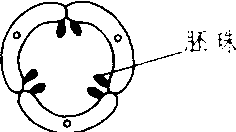侧膜胎座parietal placenta
复雌蕊中一室或假数室子房,胚珠着生于腹缝线上的胎座类型。如南瓜的雌蕊为3个心皮构成,子房一室,胚珠着生于边缘3条腹缝上;油菜等十字花科植物的雌蕊由两个心皮构成,具假隔膜,将子房分为假二室,胚珠着生于边缘的2条腹缝线上。

侧膜胎座
| 词条 | 侧膜胎座 |
| 类别 | 中文百科知识 |
| 释义 | 侧膜胎座parietal placenta复雌蕊中一室或假数室子房,胚珠着生于腹缝线上的胎座类型。如南瓜的雌蕊为3个心皮构成,子房一室,胚珠着生于边缘3条腹缝上;油菜等十字花科植物的雌蕊由两个心皮构成,具假隔膜,将子房分为假二室,胚珠着生于边缘的2条腹缝线上。
侧膜胎座 |
| 随便看 |
开放百科全书收录579518条英语、德语、日语等多语种百科知识,基本涵盖了大多数领域的百科知识,是一部内容自由、开放的电子版国际百科全书。